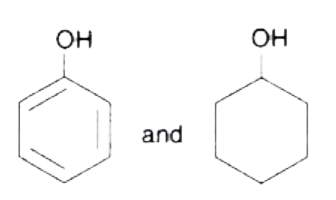Give one chemical test to distinguish between the following pairs of compounds :
Ethanol and 2 propanol.
To distinguish between ethanol (a primary alcohol) and 2-propanol (a secondary alcohol), we can use the Lucas reagent, which is a mixture of anhydrous zinc chloride (ZnCl2) and concentrated hydrochloric acid (HCl).
1. Prepare Lucas Reagent:
- Mix anhydrous ZnCl2 with concentrated HCl to prepare Lucas reagent.
2. Add the Alcohols:
- Take two separate test tubes. In one test tube, add a few drops of ethanol. In the other test tube, add a few drops of 2-propanol.
3. Add Lucas Reagent:
- To each test tube, add an equal volume of the prepared Lucas reagent.
4. Observe the Reaction:
- For Ethanol:
- Ethanol, being a primary alcohol, will react slowly with the Lucas reagent. After heating, you will observe turbidity (cloudiness) due to the formation of the corresponding alkyl chloride.
- For 2-Propanol:
- 2-Propanol, being a secondary alcohol, will react more quickly with the Lucas reagent. You will observe turbidity within a few minutes without the need for heating.
5. Conclusion:
- The formation of turbidity in the test tube containing ethanol after heating indicates it is a primary alcohol. The rapid turbidity in the test tube containing 2-propanol indicates it is a secondary alcohol. Thus, you can distinguish between ethanol and 2-propanol based on the rate of turbidity formation.
- Mix anhydrous ZnCl2 with concentrated HCl to prepare Lucas reagent.
- Take two separate test tubes. In one test tube, add a few drops of ethanol. In the other test tube, add a few drops of 2-propanol.
- To each test tube, add an equal volume of the prepared Lucas reagent.
- For Ethanol:
- Ethanol, being a primary alcohol, will react slowly with the Lucas reagent. After heating, you will observe turbidity (cloudiness) due to the formation of the corresponding alkyl chloride.
- For 2-Propanol:
- 2-Propanol, being a secondary alcohol, will react more quickly with the Lucas reagent. You will observe turbidity within a few minutes without the need for heating.
- The formation of turbidity in the test tube containing ethanol after heating indicates it is a primary alcohol. The rapid turbidity in the test tube containing 2-propanol indicates it is a secondary alcohol. Thus, you can distinguish between ethanol and 2-propanol based on the rate of turbidity formation.
Topper's Solved these Questions
Similar Questions
Give a chemical test to distinguish between the following pairs of compounds:

View SolutionWrite chemical tests to distinguish between the following pairs of compounds :
Ethanal and propanal.
View SolutionGive chemical test to distinguish between

View SolutionGive one chemical test to distinguish between the following pairs of compounds :
Ethanol and acetic acid
View SolutionGive chemical tests to distinguish between the following pairs of compounds :
Propanal and propanone.
View SolutionGive one chemical test each to distinguish between the following pairs of compounds : Propanal and Propanone.
View SolutionGive simple chemical tests to distinguish between the following pairs of compounds :
(a) Ethanal and Propanal
(b) benzoic acid and phenol
View SolutionGive simple chemical tests to distinguish between the following pairs of compounds :
(a) Ethanal and Propanal
(b) benzoic acid and phenol
View SolutionGive simple chemical tests to distinguish between the following pairs of compounds :
(a) Ethanal and Propanal
(b) benzoic acid and phenol
View SolutionGive simple chemical tests to distinguish between the following pairs of compounds :
(a) Ethanal and Propanal
(b) benzoic acid and phenol
View Solution
